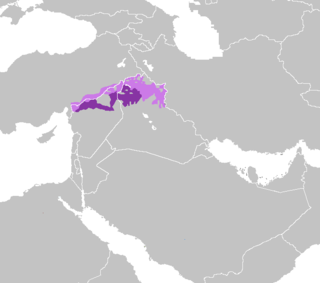

| North Mesopotamian Arabic | |
|---|---|
| Moslawi Arabic Mardelli Arabic Qeltu Mesopotamian Arabic Syro-Mesopotamian Arabic | |
| لهجة موصلية | |
| Native to | Iraq, Syria, Turkey[1] |
| Speakers | 10 million (2019–2023)[1] |
| |
| Dialects | |
| Arabic alphabet | |
| Language codes | |
| ISO 639-3 | ayp |
| Glottolog | nort3142 |
| ELP | North Mesopotamian Arabic |

| |
North Mesopotamian Arabic, also known as Moslawi (meaning 'of Mosul'), Mardelli (meaning 'of Mardin'), Mesopotamian Qeltu Arabic, or Syro-Mesopotamian Arabic, is one of the two main varietiesofMesopotamian Arabic, together with Gilit Mesopotamian Arabic.[1]
Mesopotamian Arabic has two major varieties: Gelet Mesopotamian Arabic and Qeltu Mesopotamian Arabic. Their names derive from the form of the word for "I said" in each variety.[2] Gelet Arabic is a Bedouin variety spoken by Muslims (both sedentary and non-sedentary) in central and southern Iraq and by nomads in the rest of Iraq. Qeltu Arabic is an urban dialect spoken by Non-Muslims of central and southern Iraq (including Baghdad) and by the sedentary population (both Muslims and Non-Muslims) of the rest of the country.[3] Non-Muslims include Christians, Yazidis, and Jews, until most Iraqi Jews left Iraq in the 1940s–1950s.[4][5] Geographically, the gelet–qeltu classification roughly corresponds to respectively Upper Mesopotamia and Lower Mesopotamia.[6] The isogloss is between the rivers Tigris and Euphrates, around Fallujah and Samarra.[6]
During the Siege of Baghdad (1258), the Mongols killed all Muslims.[7] However, sedentary Christians and Jews were spared and northern Iraq was untouched.[7] In southern Iraq, sedentary Muslims were gradually replaced by Bedouins from the countryside.[7] This explains the current dialect distribution: in the south, everyone speaks Bedouin varieties close to Gulf Arabic (continuation of the Bedouin dialects of the Arabian Peninsula),[7][8] with the exception of urban Non-Muslims who continue to speak pre-1258 qeltu dialects while in the north the original qeltu dialect is still spoken by all, Muslims and Non-Muslims alike.[7]
| s-stem | Bedouin/gelet | Sedentary/qeltu |
|---|---|---|
| 1st sg. | ḏạrab-t | fataḥ-tu |
| 2nd m. sg. | ḏạrab-t | fataḥ-t |
| 2nd f. sg. | tišṛab-īn | tǝšrab-īn |
| 2nd pl. | tišṛab-ūn | tǝšrab-ūn |
| 3rd pl. | yišṛab-ūn | yǝšrab-ūn |
Qeltu dialects include:[6]
The peripheral Anatolian Arabic varieties in Siirt, Muş and Batman are quite divergent.[citation needed]
Cypriot Arabic shares a number of common features with North Mesopotamian Arabic, and one of its pre-Cypriot medieval antecedents has been deduced as belonging to this dialect area.[11][12] However, its current form is a hybrid of different varieties and languages, including Levantine Arabic and Greek.[11]
|
Arabic language
| |||||||||||||||||||||||||||||||||||||
|---|---|---|---|---|---|---|---|---|---|---|---|---|---|---|---|---|---|---|---|---|---|---|---|---|---|---|---|---|---|---|---|---|---|---|---|---|---|
| Overviews |
| ||||||||||||||||||||||||||||||||||||
| Scripts |
| ||||||||||||||||||||||||||||||||||||
| Letters |
| ||||||||||||||||||||||||||||||||||||
| Varieties |
| ||||||||||||||||||||||||||||||||||||
| Academic |
| ||||||||||||||||||||||||||||||||||||
| Linguistics |
| ||||||||||||||||||||||||||||||||||||
| Calligraphy · Script |
| ||||||||||||||||||||||||||||||||||||
| Technical |
| ||||||||||||||||||||||||||||||||||||
| Other |
| ||||||||||||||||||||||||||||||||||||
| |||||||||||||||||||||||||||||||||||||
This article related to the Arabic language is a stub. You can help Wikipedia by expanding it. |
This Iraq-related article is a stub. You can help Wikipedia by expanding it. |
This Iran-related article is a stub. You can help Wikipedia by expanding it. |
This Syria-related article is a stub. You can help Wikipedia by expanding it. |
This Turkey-related article is a stub. You can help Wikipedia by expanding it. |